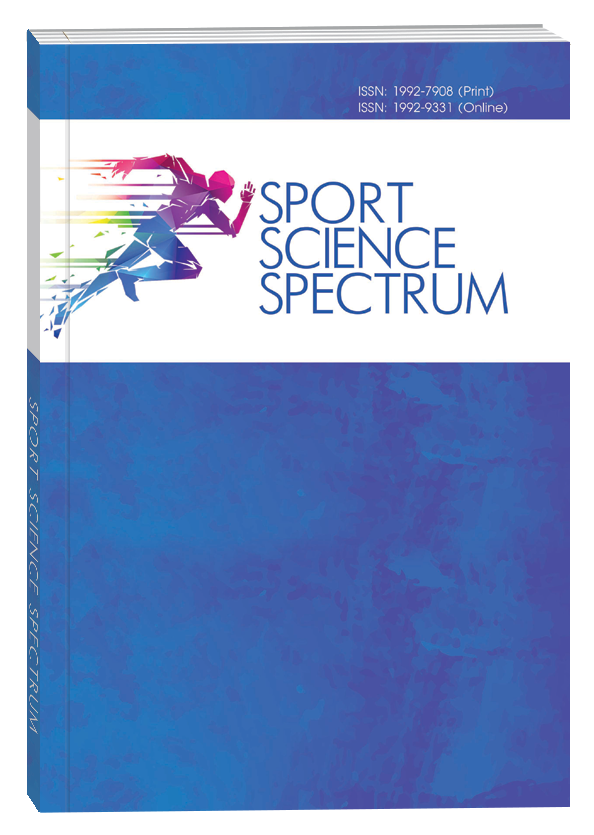MODERN APPROACHES TO THE FORMATION OF NATIONAL TEAMS BY PLAYERS OF DIFFERENT PLAYING ROLES IN VOLLEYBALL
DOI:
https://doi.org/10.32782/spectrum/2024-3-3Keywords:
technical and tactical actions, formation of national teams, modeling, reference models, training system, universal playersAbstract
Achieving success in the most important international competitions in team sports, volleyball in particular, is impossible without an effective system of training players of different roles, which corresponds to global trends and the formation of national teams. The article considers the peculiarities of formation of women’s national teams in volleyball based on the analysis of competitive activity of players of different playing roles and modeling the effectiveness of their technical and tactical actions. The aim is to substantiate the trends in the formation of national teams in volleyball on the basis of model indicators of players of different game roles in international practice. Methods. The research used the analysis of data from special scientific and methodical literature and the Internet, comparison and contrast, pedagogical observation, analysis of protocols of competitive activity, generalization and methods of mathematical statistics. The analysis of the competitive activity of volleyball players of different game roles was carried out based on the results of their performance in the Nation League 2023–2024. In total, 144 games were analyzed and 60428 technical and tactical actions were registered. The data obtained were processed using standard statistical methods included in the Statistics 7.0 software package. The results of the study show that the main factor in the formation of national teams is the effectiveness of the competitive activity of players of different game roles, where the most important place is occupied by compliance with model indicators of the effectiveness of technical and tactical actions. It has been determined that the most important indicators in the selection of players for national teams are performance indicators: in preplaying – attacking shots, receiving the ball and defensive actions; in diagonal – attacking and defensive actions; in central blockers – attacking shots and blocking; in linking – ball passing and defensive actions; libero – defensive actions and receiving the ball. Also when comparing the reference models of the best volleyball players of the world and the average values of model indicators, it is established that there are significant differences (in the direction of increase of the first) in the performance of effective technical and tactical actions, which testifies to the selection of highly technical players with individually expressed abilities to the national teams. Conclusions. Comparison of individual indicators of technical and tactical actions of volleyball players of different game amplitude with average model indicators of competitive activity make a prerequisite for the effective formation of national teams in international practice.
References
1. Сучасні підходи удосконалення змагальної діяльності висококваліфікованих спортсменів у спортивних іграх. Теорія та методика фізичного виховання / О. Борисова та ін. 2020. № 2. С. 15–22. URL: http//doi org/10.32652/tmfvs.2020.2.15–22
2. Борисова О., Дутчак М., Шльонська О. Аналітичний огляд сучасних наукових досліджень за проблемою підготовки спортсменів різного ігрового амплуа в командних ігрових видах спорту. Спортивна наука та здоров’я людини. 2024. № 1(11). С. 39–57. URL: https://doi.org/10.28925/2664-2069.2024.14
3. Костюкевич В.М. Теорія і методика спортивної підготовки (на прикладі командних ігрових видів спорту) : монографія. Вінниця, 2014. 616 с.
4. Ляхова Т.П. Змагальна діяльність найсильніших гравців першого темпу з волейболу у світовій першості. Проблеми і перспективи розвитку спортивних ігор та одноборств у закладах вищої освіти. 2023. С. 80–83.
5. Олійник М.О., Дорошенко Е.Ю. Визначення модельних характеристик висококваліфікованих волейболістів різного амплуа. Науковий часопис НПУ імені М.П. Драгоманова. 2017. № 8 (90). С. 44–47.
6. Barzouka K., Sotiropoulos K., Drikos S., Kitsiou A., Angelonidis Y. Current trends of the serve skill inrelation to the in-game roles of the elite volleyball players: Comparison between genders. Journal of Human Sport and Exercise. 2021. Vol. 16 (2). Р. 317–332. URL: https://doi.org/10.14198/jhse.2021.162.087. Bompa Т. G. Haff Periodization: theory and methodology of training. 2009. 411 р.
8. Budak G. and Kara İ. A multiobjective mathematical model to form the best team at sports clubs: team harmony and player performance objectives. Team Performance Management. 2022. Vol. 28(3/4). Р. 145–159. URL: https://doi.org/10.1108/TPM-06-2021-0047
9. Challoumas D., Artemiou A. Predictors of attack performance in high-level male volleyball players. International Journal of Sports Physiology and Performance, 2018. Vol. 13(9). Р. 1230–1236.
10. Denardi R.A., Romero Clavijo F.A., De Souza Santana T., Costa De Oliveira T.A. & Corrêa, U.C. The interpersonal coordination constraint on the volleyball setter’s decision-making on setting direction. Journal of Human Sport and Exercise. 2024. Vol. 19(3). Р. 891-900. URL: https://doi.org/10.55860/d5eepb18
11. Đurković T., Pašuld M., Kresoja D. Somatotypes of Top Croatian Male Volleyball Players. Sport Mont. 2023. Vol. 21(2). Р. 71–77. URL: https://DOI:10.26773/smj.230711
12. Eom H.G. & Schutz R.W. Statistical analyses of volleyball team performance. Research Quarterly for Exercise and Sport, 1992. Vol. 63 (1). Р. 11–8. URL: http//doi org/10.1080/02701367.1992.10607551
13. Fellingham G.W. Evaluating the performance of elite level volleyball players. Journal of Quantitative Analysis in Sports. 2022. Vol. 18(1). Р. 15–34. URL: http//doi org/10.1515/jqas-2021-0056
14. Forrat-Fuster S., Bazuelo-Ruiz B. Observational analysis of the one-leg attack of the central player in female volleyball. Retos. 2024. Vol. 51. Р. 1424–1430. URL: http//doi org/10.47197/retos.v51.101064
15. García-de-Alcaraz A., Ortega E., Palao J.M. Technical-tactical performance profile of the block and dig according to competition category in men’s volleyball. Motriz. 2016. Vol. 22 (2). Р. 102–109. URL: https://doi.org/10.1590/S1980-6574201600020013
16. Li F.S, Jia N., Zheng H. Nonlinear Random Matrix Model and Research for Quantitative Representation of Volleyball Attacker’s Action Links. Mathematical problems in engineering. 2022. URL: https://doi.org/10.1155/2022/2279813
17. Lima R.F., Morais C., Resende R. The influence of set speed on the attack efficacy of the outside hitter in elite male volleyball. Retos-nuevas tendencias en educacion fisica deporte y recreacion. 2024. Vol. 58. Р. 823–828.
18. Malikova A.N., Doroshenko E.Yu., Symonik A.V., Tsarenko E.V., Veritov A.I. The ways of improvement special physical training of high-qualified women volleyball players in competitive period of annual macrocycle. Physical education of student. 2018. Vol. 22(1). Р. 38–44. URL: DOI:10.15561/20755279.2018.0106
19. Matthew F.F., Juliette S., Mark C. Coulson S.P. The information coaches use to make team selection decisions: a scoping review and future recommendations. Sports Coaching Review. 2021. Р. 187–208. URL: https://doi.org/10.1080/21640629.2021.1952812
20. Millán-Sánchez A, Rábago J.C.M. and Espa A.U. The middle blocker in volleyball: A systematic review. Journal of human sport and exercise. 2019. Vol. 14 (1). P. 24–45. URL: DOI: 10.14198/jhse.2019.141.03
21. Mireille M., Johan P., Matthieu L. Pieter V. A retrospective analysis of the national youth teams in volleyball: Were they always faster, taller, and stronger? Journal Strength Cond Res. 2022. Vol. 36(9). P. 2615–2621. URL: DOI:10.1519/JSC.0000000000003847
22. Shen G.P. and Fan Y. Wave propagation in a volleyball game ball: finite element and mathematical simulation. Waves in random and complex media. 2023. URL: DOI10.1080/17455030.2023.216808
23. Shlonska O., Borysova O., Yakusheva Yu. Сучасні аспекти формування національних збірних команд ігрових видів спорту в умовах глобалізації. Rehabilitation and Recreation. 2024. Vol. 18(3). P. 239–252. URL: https://doi.org/10.32782/2522-1795.2024.18.3.22
24. Shoval S. and Barron Y. A probabilistic approach to the analysis of a volleyball set performance. Journal of the Operational Research Society. 2019. P. 714–725.
25. Sotiropoulos K., Drikos S. Barzouka K. Variations in attack patterns between female and male opposite players in top-level volleyball. International Journal of Sports Science & Coaching. 2022. Vol. 17(2). P. 400–411. URL: DOI10.1177/17479541211030633
26. Tsavdaroglou S., Sotiropoulos K., Barzouka K. Comparison and assessment of the setting zone choices by elite male and female volleyball setters in relation to opposing block organization. Journal of Physical Education and Sport. 2018. Vol. 18(5). P. 2147–2152. URL: https://doi.org/10.7752/jpes.2018.s532





